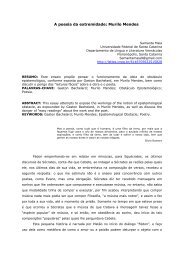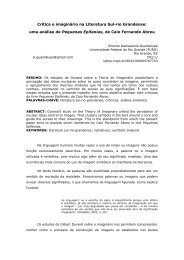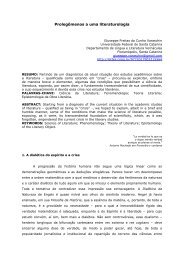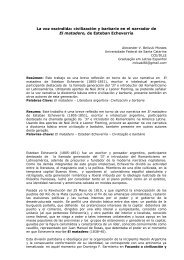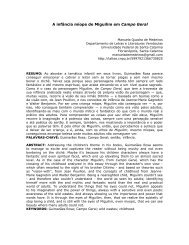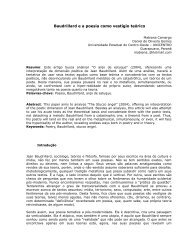Incongruity and Comicality in Woody Allen's prose
Incongruity and Comicality in Woody Allen's prose
Incongruity and Comicality in Woody Allen's prose
Create successful ePaper yourself
Turn your PDF publications into a flip-book with our unique Google optimized e-Paper software.
him. Sherry falls <strong>in</strong>to his trap, <strong>and</strong> Kaiser f<strong>in</strong>ally reveals that he is a cop: “I´m fuzz,<br />
sugar, <strong>and</strong> discuss<strong>in</strong>g Melville for money is an 802. You can do time.” (Ibid., p. 55)<br />
Then, the girl, desperately cry<strong>in</strong>g, is forced to conduct Kaiser to Flossie.<br />
Accord<strong>in</strong>g to Sherry, Flossie manages her illegal bus<strong>in</strong>ess <strong>in</strong> the back of the<br />
Hunter College Book Store. Kaiser goes there, <strong>and</strong> beh<strong>in</strong>d a secret wall of books, he<br />
f<strong>in</strong>ds many young <strong>and</strong> beautiful women read<strong>in</strong>g. Suddenly, someone surprises the<br />
detective with a gun. It is Flossie (who is actually a man with a woman’s voice, due<br />
to an unsuccessful plastic surgery). Rapidly, the detective makes a move <strong>and</strong> grabs<br />
the gun from Flossie. The police arrive <strong>and</strong> arrest the ‘madam’. Later that night<br />
Kaiser looks up Gloria, an old account of his who had graduated cum laude – “The<br />
difference was she majored <strong>in</strong> physical education.” (Ibid., p. 57)<br />
As many of the short stories <strong>in</strong>cluded <strong>in</strong> Without Feathers, the plot <strong>and</strong><br />
the language of “The Whore of Mensa” are notably structured on <strong>in</strong>congruent<br />
<strong>and</strong> nonsensical elements. The very fact that the ‘prostitutes’ alluded <strong>in</strong> the text<br />
are not exactly ‘common prostitutes’, but are rather women paid for engag<strong>in</strong>g <strong>in</strong><br />
philosophic <strong>and</strong> literary discussions with ‘<strong>in</strong>tellectually unsatisfied’ men, already<br />
puts the reader <strong>in</strong> confront with a ‘strange’ <strong>and</strong> ‘unusual’ reality. Besides, not only<br />
the plot but also the dialogues, the atypical associations, l<strong>in</strong>guistic choices <strong>and</strong><br />
especially the images evoked throughout the whole piece result <strong>in</strong> this <strong>in</strong>ventive,<br />
uncommon <strong>and</strong> extremely comic narration. In fact, as Isabel Ermida (2011, p.<br />
351) shows, “the semantic organisation of [<strong>Woody</strong> Allen’s] texts, based on a<br />
comb<strong>in</strong>ation of script oppositeness <strong>and</strong> overlap, is blended with a proficient use of<br />
stylistic devices which signal, <strong>and</strong> enhance, comic <strong>in</strong>congruity.” Although Ermida is<br />
specifically consider<strong>in</strong>g Allen’s Mere Anarchy (2007), this general assumption can<br />
be also applied to many of the pieces <strong>in</strong>cluded <strong>in</strong> Without Feathers.<br />
Accord<strong>in</strong>g to Ermida (2011, p. 340), most theories of l<strong>in</strong>guistic humour<br />
acknowledge that <strong>in</strong>congruity is the key to comic effect. By <strong>in</strong>congruity, Ermida<br />
refers to “a discrepancy between two mean<strong>in</strong>gs which overlap, <strong>and</strong> correspond<strong>in</strong>g<br />
surprise” that “establishes the humorous nature of an utterance.” Yet, <strong>in</strong> rhetorical<br />
terms, we could even establish an association between the comic <strong>in</strong>congruity<br />
<strong>and</strong> the conception of trope, traditionally understood “as the figure created by<br />
dislodg<strong>in</strong>g of a term from its old sense <strong>and</strong> its previous usage <strong>and</strong> by transferr<strong>in</strong>g<br />
a new, improper, or ‘strange’ sense <strong>and</strong> usage.” (CONTE, 1986, p. 23) Hence,<br />
when I suggest that Allen makes use of <strong>in</strong>congruity as a mechanism to produce<br />
comicality, I am try<strong>in</strong>g to argue that the comic effects obta<strong>in</strong>ed through his texts<br />
are fundamentally related to the overlap, or rather to the dislodg<strong>in</strong>g of a known <strong>and</strong><br />
conventional situation, sign or image <strong>in</strong>to an unusual frame, as it may be attested<br />
<strong>in</strong> the follow<strong>in</strong>g example:



